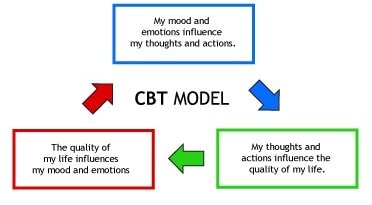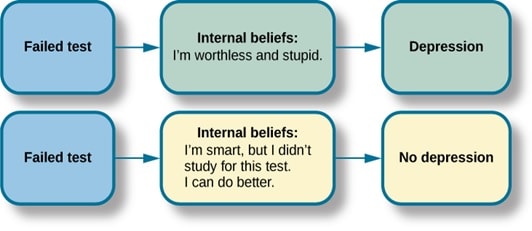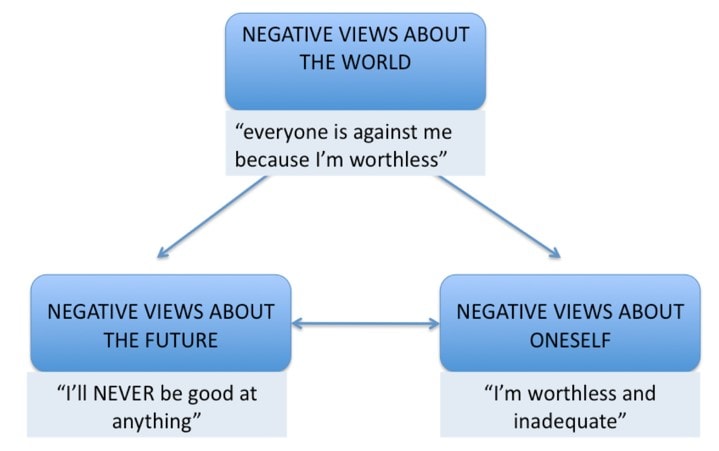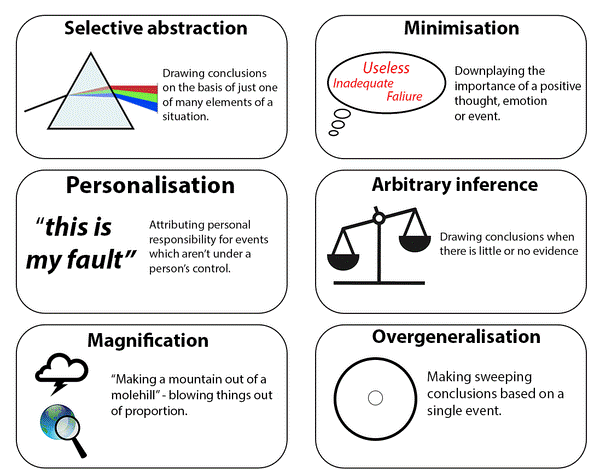Cognitive behavioural therapy
Cognitive behavioural therapy is a form of short-range therapy that is practised by the counsellors in psychology. Cognitive behavioural therapy (CBT) is rooted in the basic principle that an individual’s cognition plays an important role in the development and maintenance of the emotional and behavioural response to the situations in life. This theory plays a noteworthy role in showing how negative thoughts can influence our emotions and behaviour. The term “Cognitive-behavioural” imitates how both cognitive and behavioural approaches are required to understand and help people. It is a type of talking therapy that can be used to treat people with an extensive series of metal health problems.
Dr. Aaron Beck observed that his various clients had ‘automatic thoughts’- “emotion-filled thoughts that might pop up in mind”. There is a number of thoughts that the client is unaware of and the thoughts tend to influence his mood and behaviour. However, by practise, the client can become aware of the rational and irrational thought and upon identifying the basic difference between the negative and positive thoughts can become able to learn to how to overcome the negative thoughts. “CBT is a based on the theory that is, that it is not about the events that upset us but is about the meanings that we give to them” (Essays in Psychology, 2019; Mcleod, 2019; Prendes, 2019).

(Ekam child development centre, 2019)
There were two forms of Cognitive Behavioural Therapy – Rational Emotive Behavioural Therapy (REBT) given by Albert Ellis in 1950s and Cognitive therapy given by Aaron T. Beck in 1960s.
- REBT was developed by Albert Ellis in the 1950s which emphases on resolving behavioural and emotional problems by letting the client know the difference in rational and irrational thought and then heartening the client to practise the false thoughts through reality testing. Albert said that every one of us holds a subset of assumptions about us and about the world that influences our response to the various situations, but unfortunately, some people have an irrational subset of thoughts towards things happening in their life that prejudices their chance of being happy and successful. These people feel that they are the failures if they are not loved or valued by others. They constantly need approvals and compliments that they are important. Hence, all the interactions are disturbed with the irrational feedback of the thoughts. This what Albert says the basic irrational assumptions and they are-
- The thought that one must be competent at everything.
- The thought of being catastrophic when things are not the way they want them to be.
- One is not having any control over his happiness.
- The idea of that you need someone else over yourself to be dependent upon.
- The idea that your present life is greatly influenced by your past.
- The idea of that to every problem there is a perfect solution out there and if you are unable to find it then it is a big disaster.
Cognitive behavioural therapy Assignment Help By Online Tutoring and Guided Sessions from AssignmentHelp.Net
He believed that people are forcefully stick on the irrational ways of thinking, therefore, the implication of emotive techniques can immensely influence their irrational thinking to change (Mcleod, 2019).
- THE ABC MODEL- An Aid to Cognitive Therapy:
Given by Albert Ellis in 1957. The first three steps give an analysis to the process that how the person might have developed irrational thoughts and it can then be recorded.

- ACTIVATING EVENT or OBJECTIVE SITUATION
This step helps to record the objective situation that lead to some type of emotional outbreak or negative thoughts.
- BELIEFS
This stage lets the client write down the negative thought that occurred because of the event.
- CONSEQUENCE
This stage is to ensure the negative feelings and dysfunctional behaviour. As the negative feelings of the second stage were seen to work as a bridge between the situation and distressing feelings. This stage is hence explained by relating emotions or negative thoughts that were caused by stage A. This may include anger, sorrow or anxiety, etc.
According to Ellis, the negative emotions or the behavioural consequences (C) are not the resultants of stage A but rather, how the client interprets those events based on his irrational belief system which helps him to reach to the stage C.
For Example: -

(Lumen Learning-Introduction to psychology, 2019)
Dr. Ellis later modified the technique and added three more steps i.e. Disputing (D); New Effect (E) and Further Action (F). Once the client becomes efficient to overcome A, B and C then he can move forward and tests his ‘Beliefs’ through ‘Disputing’. Then, they can also choose to how they to prefer what they feel or mold their behaviour which accounts for the New Effect and finally accordingly he could plan how to develop Further Action in order avoid a relapse (Mcleod, 2019).
- COGNITIVE THERAPY was given by Aaron Beck in 1967. This theory is quite similar to that of Ellis but has been widely used for the clients of depression. Cognitive therapists direct the client to challenge their dysfunctional thoughts and to try new interventions and apply the alternative ways of thinking on a day-to-day basis. When a client portrays a stream of negative thoughts, the end result of that behaviour is depression. Beck recognized three mechanisms that lead to depression and these were:
- The cognitive triad
- Negative self-schemas
- Errors in logic
- THE COGNITIVE TRIAD: The triad displays three forms in which the client thinks e. irrational thoughts about self, the surrounding world and the future. This sense of behaviour is automatic in the clients having depression. As the three components intermingle with one another, they lead to the impairment of normal cognitive processing. The client faces diminished ability to solve problems, has weakened memory and poor
- perception as and when he becomes occupied with negative thoughts.

- NEGATIVE SELF-SCHEMAS: Beck observed individuals who are depression-prone have errored thinking process and selectively focus on certain matters ignoring relevant information. These clients have a negative and pessimistic set of beliefs about themselves. Beck observed that this kind of mental set back could be an outcome of traumatic events such as:
- Parent’s or sibling’s death
- Parental denial, condemnation, overprotection, mistreatment or negligence.
- Harassment at school or omission from the peer group (Mcleod, 2019).
- COGNITIVE DISTORTIONS: Beck identifies that there are distortions that have been observed in the client’s thinking process. These type of irrational thinking patterns are self-defeating and become a cause for anxiety or depression.
- Arbitrary interference: Making conclusions based on sufficient or inappropriate information.
e.g.: - Thinking that you are worthless because you could not make it go to an open-air concert.
- Selective abstraction: Paying attention to a single aspect while ignoring rest.
e.g.: - You feel responsible for loosing a dance competition when even though you are just one of the members of the team.
- Magnification: - Overstating the value of undesirable events.
e.g.: - If you scrape a bit of your paintwork and assume yourself as an awful driver.
- Minimisation: - Underestimating the worth of an event.
e.g.: - If you get praised of your work but you still assume yourself as the minor.
- Overgeneralization: - Concluding broad pessimist opinions based upon the single insignificant occasion.
e.g.: - When you get low marks once and thinks yourself as the most idiotic person on this earth.
- Personalization: - Accrediting negative feelings of others to yourself.
e.g.: - The teacher got disheartened because of my lesser grades (Mcleod, 2019).

(Anon, 2019)
Differences between REBT and Cognitive Therapy: -
- Ellis viewed the therapist as a teacher and did not give importance to the warmth of the relationship between the client and the therapist, whereas, Beck valued the quality of the relationship.
- REBT is highly dictating, influential and confronting, whereas, Beck believed in discovering the client’s misconception about himself.
- REBT implies different methods according to the personality of the client, whereas, Beck was more focussed on the disorder (Mcleod, 2019).
Strengths of Cognitive Behavioural Therapy: -
- The model has a great petition because it pays importance on human thoughts, as if, human cognitive abilities help in gaining accomplishments then they would definitely play a role in solving the problems.
- These theories offer themselves to testing as when an experimental subject is offered any unpleasant situation, he gets depressed or faces anxiety.
- People with a psychological disorder, specifically those have been facing depression; anxiety or have sexual disorders have been found to exhibit maladaptive conventions and thoughts.
- Cognitive therapy is more effective in treating clients with depression and moderately with those who have anxiety disorders (Mcleod, 2019).
Limitations of the Cognitive Behavioural Model: -
- The cognitive model has a narrower aspect and the broader aspect is yet to be defined.
- Ethical issues: REBT is a directive technique whose objective is to change the cognitions, at times forcefully and this approach is sometimes considered as unethical.
- The precisive role of the therapy is yet to be defined as it is unclear that cognitions are the cause or the consequence of the psychopathology (Mcleod, 2019).
References
Anon, (2019). Cognitive Distortion. [online] Available at https://www.academia.edu/266193/Cognitive_Science_of_LAW_An_Introduction_ppt-pdf_1.5M_text_in_Korean_ [Accessed 17 Jul. 2019].
Ekam child development centre. (2019). Cognitive Behavior Therapy | Cognitive-behavioral therapy is a psycho-social intervention that aims to improve mental health. CBT focuses on challenging and changing unhelpful cognitive distortions and behaviors, improving emotional regulation, and the development of personal coping strategies that target solving current problems. Originally, it was designed to treat depression, but its use has been expanded to include treatment of a number of mental health conditions, including anxiety. | Ekam child development centre. [online] Available at https://ekamchilddevelopmentcentre.advertroindia.co.in/viewproduct.php?id=28387 [Accessed 17 Jul. 2019].
Lumen Learning-Introduction to psychology. (2019). Cognitive Behavioural Therapy. [online] Available at https://Assignments.lumenlearning.com/wmopen-psychology/chapter/cognitive-therapy/ [Accessed 17 Jul. 2019].
Mcleod, S. (2019). Cognitive Behavioral Therapy | CBT | Simply Psychology. [online] Simplypsychology.org. Available at: https://www.simplypsychology.org/cognitive-therapy.html [Accessed 17 Jul. 2019].
Prendes, A. (2019). Cognitive Behavioural Therapy. [online] Sagepub.com. Available at: https://www.sagepub.com/sites/default/files/upm-binaries/40689_2.pdf [Accessed 17 Jul. 2019].
UKEssays.com. (2019). Cognitive Behavioral Theory. [online] Available at https://www.ukessays.com/essays/psychology/the-cognitive-behavioral-theory-psychology-essay.php#cite [Accessed 17 Jul. 2019].


